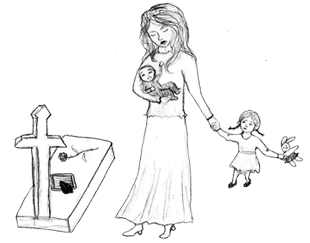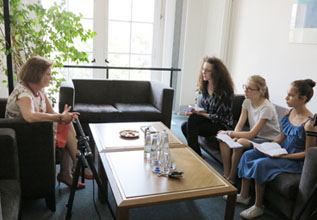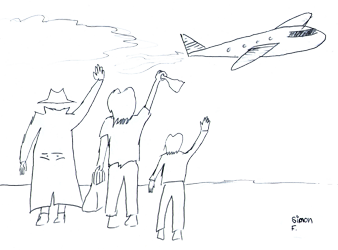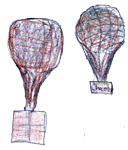Stiftung Luftbrückendank - Airlift Gratitude Foundation

When enemies became friends
The Berlin Airlift saved many lives: a whole city was supplied with the help of airplanes, pilots and other helpers. Marion Werwoll, Managing Director of Stiftung Luftbrückendank (Airlift Gratitude Foundation) tells the young reporters from the Böser Wolf (Big Bad Wolf) about the role of the foundation.
Since when does the Stiftung Luftbrückendank exist?
 It was set up in 1959 by the governing Mayor of Berlin at that time, Willy Brandt, who asked for donations to help remembering the 78 victims of the Berlin Airlift.
It was set up in 1959 by the governing Mayor of Berlin at that time, Willy Brandt, who asked for donations to help remembering the 78 victims of the Berlin Airlift.
How did the foundation help?
The intention was to help the relatives of the victims so that they could receive a good education. The pilots who died were very young, they had little children. Their wives remained alone without financial security. Many of them had fallen into poverty. That's why the foundation took care of them. Today it is different; there is only one widow alive, she is 97 years old.
What exactly does the foundation do?
Now we want to say thanks by supporting children from those countries that helped u s then, the United States, the United Kingdom, and France. We are funding projects for young people; recently a group of young Berlin students went to the United States to see one of the last pilots of the time, Gail Halvorsen. Without our support, this trip would not have been possible. We also invited a hip-hop band from Detroit to Berlin.
s then, the United States, the United Kingdom, and France. We are funding projects for young people; recently a group of young Berlin students went to the United States to see one of the last pilots of the time, Gail Halvorsen. Without our support, this trip would not have been possible. We also invited a hip-hop band from Detroit to Berlin.
Our goal is to preserve the memory of the Berlin Airlift, to ensure that young people are interested and to show them how this event happened. To keep this basic idea in mind: enemies became friends. Because there are still many problems, wars in the world. We need to help these countries rebuild and show people that there is always hope. It's never the end.
You are the president of the foundation. What are you doing exactly?
I have to make sure that the money is invested profitably, so that we have enough money that we can spend. That is how foundations work, you have a certain basic sum, in our case it's 4.2 million Euros, but we're not allowed to use it. We can only spend the interest this sum brings us. And it's not a lot at this moment.
In addition, I have to develop ideas, think about the projects we could do, in which direction we should go. I have an employee to carry out this work.
Why is it im portant to keep the memory of the Airlift alive?
portant to keep the memory of the Airlift alive?
Because it was a big logistic challenge at that time. It took place from June 1948 until September 1949. The whole city was locked up, no food, no coal came in and we could not get out. West-Berlin would have starved. The Airlift was carried out at 2-minutes intervals; everything was brought inside the city by airplanes. It is some kind of event that we should remember. It never occurred in this form again. Without the airlift the world would look different today. The outbreak of the Third World War was very close.
What should teenagers learn from it?
That enemies can become friends. Only three years earlier the countries that helped us were massively attacked by Hitler. A lot of people died. And suddenly they said: “there is a city which is starving, we’re helping you, even if you tried to kill us just before“.
Are there any specific plans the foundation has for the near future?
Yes, we want to expand our work, work closer with schools, because there is only a 20 minutes-lesson planned for the Airlift at class. We want to support schools financially, so that they can realize projects to work on this subject on a more extensive level: what does it mean today, what do we learn from it, what does it mean for the future, is there any kind of hope after a war….
Do you remember the first time you heard about the Airlift?
 I had heard about it at home when I was a child, because my parents grew up in West-Berlin. I know that my father and my uncle always used to walk in the direction of Tempelhof, they didn’t have any bikes. They lived in Reinickendorf (in the north) and walked until Kreuzberg (in the center). They waited there until the parachutes with sweets would be dropped off. At that time, a candy or a bar of chocolate was something really special.
I had heard about it at home when I was a child, because my parents grew up in West-Berlin. I know that my father and my uncle always used to walk in the direction of Tempelhof, they didn’t have any bikes. They lived in Reinickendorf (in the north) and walked until Kreuzberg (in the center). They waited there until the parachutes with sweets would be dropped off. At that time, a candy or a bar of chocolate was something really special.
Was the topic of the Airlift important during your childhood?
 The Airlift led up to the construction of the Berlin Wall in 1961. Every year at Christmas, my Grandma would put candles by the windows to give a message of hope: „we did not forget them on the other side“. As a child it was something you encountered. There were relatives living on the other side with whom you could not have contact anymore. The Four Powers Agreement on travel and visit conditions and the agreement between the senate of West-Berlin and the DDR government in 1971 gave us the possibility to visit them again. It took a lot of work, huge applications to fill, but it was better than the years before when families were separated. That was also a consequence of the Airlift.
The Airlift led up to the construction of the Berlin Wall in 1961. Every year at Christmas, my Grandma would put candles by the windows to give a message of hope: „we did not forget them on the other side“. As a child it was something you encountered. There were relatives living on the other side with whom you could not have contact anymore. The Four Powers Agreement on travel and visit conditions and the agreement between the senate of West-Berlin and the DDR government in 1971 gave us the possibility to visit them again. It took a lot of work, huge applications to fill, but it was better than the years before when families were separated. That was also a consequence of the Airlift.
Did the work of the foundation allow you to make nice encounters?
Of course, it is always very nice when you have the opportunity to share memories. Those pilots meetings are very touching. I can remember stories told in the family of how weird it was then. And then you see this old, 96 years old man who contributed to the rescue of West-Berlin, that is really emotional.
